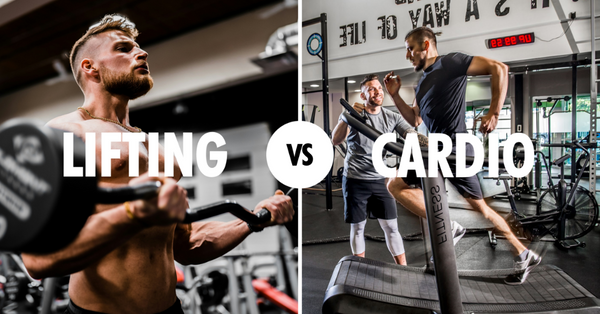Tip: For Muscle Growth, Chase the Burn

We all know the burn that comes with taking a high rep set to absolute failure. Some love the feeling, some hate it, but we're all told the same thing's causing it.
Lactic acid. Most athletes see it as a villain, the cause of muscle fatigue, burn and delayed onset muscle soreness (aka DOMS). We’ve been led to believe it’s a waste product that builds up when our muscles work.
We're told we need to buffer or block lactic acid in various ways. The most common approach is to supplement with huge, skin-crawling doses of the amino acid beta alanine to counteract it.
From the non-supplement side, coaches frequently recommend athletes use massage or ice baths to "flush" excess lactic acid out (how these would actually remove lactic acid, or where it would go, is anyone's guess).

But the latest research suggests that our bodies don’t, in fact, produce lactic acid when we exercise.
Turns out, lactic acid — at least as we thought we knew it — is mostly just myth.
In fact, it may be the single most misunderstood subject in all of fitness.
During intense training our bodies create something called lactate.
Wait, Lactate? Like Milk?
The word 'Lactate' might raise a few eyebrows, as the prefix 'lact' means "milk" in Latin... and it sounds dangerously similar to "lactation", which is the polite term for breast feeding. Awkward, right?

Fear not. Neither lactate (what your muscles are producing during training) nor lactic acid (what people think their muscles are cranking out) have anything to do with udders, lactose, or breast milk. Zero. Zilch. Nada.
So why the "lact" sounding names?
Lactic acid was first discovered in a sample of sour milk. This was purely a coincidence; lactic acid does not have anything to do with milk specifically and could have been found in any number of places or substances.
So lactic acid (C3H6O3) got it's milky-sounding "lact" name from the first place it was found. Lactate (C3H5O3) inherited a form of the same goofy name when it was identified later on.

It may seem like only a minor difference – but the implications for optimizing strength, muscle, speed, and endurance are massive.
Consider the following:
Lactate not a waste-product at all, and it serves an incredibly important purpose for fueling your best workouts.
In fact, lactate is the opposite of lactic acid. It's lactic acid's alkaline (non-acidic) form.
Better still, lactate is anabolic, and its accumulation in muscle tissue may be a critical step the body takes to prime muscles to heal and grow.
Has lactic acid/lactate been misunderstood all these years? Read on for the truth behind the burn.

The Lactic Acid Myth
For years, we’ve been told by coaches, trainers and science teachers that lactic acid causes our muscles to ache and tire when we exercise intensely.
The theory was that when the body breaks down glucose for energy, it produces lactic acid as a by-product. Researchers concluded that the accumulation of lactic acid — and the increasing acidic environment in our muscles — is what caused muscle fatigue and failure.
“However, there is no experimental research to prove this. Just correlative data,” says Dr. Jeremy McCormick, at the University of New Mexico.
Ever since lactic acid was first linked to exercise metabolism in the 1920s, this theory went largely unquestioned for more than 80 years.
A closer look at the biochemistry involved during exercise reveals a different story altogether.
When we lift, our bodies require quite a lot of energy to fuel muscle contraction. Our cells break down the energy molecule ATP, and an acidic hydrogen ion is released in the process.
For the body to continue clearing these hydrogen ions, a certain level of oxygen has to be present.
During intense exercise, oxygen is limited (think high rep sets, sprinting, etc), and our metabolism can’t keep up with the ever-growing number of acidic hydrogen ions in our body.
It’s actually this accumulation of hydrogen ions that makes the surrounding environment acidic and causes our muscles to burn – not an increase in lactic acid.

If too many hydrogen ions are the culprit, then why does everyone blame lactic acid? How did we all get it wrong for so long?
As exercise intensity increases, our bodies rely on glucose to keep up with the demand for energy. One of the end products of the breakdown of glucose is pyruvate, and this molecule begins to build up in our cells along with the hydrogen ions.
Since our body doesn’t want these concentrations to rise unchecked, each molecule of pyruvate absorbs two of the hydrogen ions, forming lactate.
“Scientists have been confused because lactate and hydrogen ions are present together in the muscle when you exercise intensely, and they thought it was lactic acid,” says McCormick. “But it’s really lactate,” he says.
Back when these theories were forming in the 1920's, it was an easy mistake to make.
Lactate is almost lactic acid. Essentially, scientists saw tons of C3H5O3 (lactate) alongside a bunch of hydrogen (H) ions and mistakenly connected the two, slapping an extra H in there and mislabeling it as C3H6O3 (lactic acid).
With more advanced tools and methods, we're now able to tell the difference, but the myth dies hard.
So now that that we've put lactic acid to bed, what's the deal with lactate?

Friend or Foe?
To keep our muscles functioning during intense exercise, our bodies try to reduce the acidic environment by neutralizing the growing number of hydrogen ions.
Lactate doesn’t cause the acidic environment -- it works to minimize it. It’s when this buffering process can’t keep up that our muscles start to burn.
“If we didn’t produce lactate, we would have an accumulation of hydrogen ions. Our muscles would get too acidic, as the pH [a measure of acidity/alkalinity] keeps dropping to a point where muscles won’t function,” says McCormick. “Basically, you’d have mechanical failure.”
During mild training, our muscles produce some lactate, and it mops up all the acidity without any problems.
When we train hard, “we hit a threshold where hydrogen ions accumulate, and you can’t clear it as fast as you’d like,” says McCormick. That accumulation of acidity is the burn you feel, while lactate is hustling to cool things down and keep you in the game.
Not only does lactate serve as a natural acid buffer, research also indicates that our bodies reuse lactate as a source of energy for our muscles, heart and brain.
During moderate and hard exercise, it can be shuttled back into the mitrochondria of muscle cells (the fuel burning component of your cells) and converted into energy.

But, this energy efficient system requires a specific oxygen threshold to be present. As an athlete fatigues during a hard workout, oxygen levels fall.
Eventually the system begins to accumulate acid faster than it can clear it, and loses the ability to convert lactate back into energy to fuel working muscles.
With energy systems collapsing and acidity spiking, performance plummets.
What Can Be Done?
Supplementing with the amino acid beta alanine is a good start. It reduces muscle acidity to keep you crushing reps – although the commonly provided explanation that beta alanine blocks “lactic acid” is misleading.
As we’ve now learned, what it's actually doing is blunting the effects of acidic hydrogen ions.
However, beta alanine alone is an incomplete approach.
Even with beta alanine keeping acidity at bay, oxygen levels continue to fall at the same rate, and the production of muscle lactate will fail once oxygen levels get too low.
Reps, sets, and muscle building potential gets left on the table as the energy system becomes starved for oxygen.
That's where octacosanol comes in.
Supplementation with the long chain alcohol octacosanol has a broad range of muscle building benefits, but of particular interest is its ability to raise oxygen levels and promote muscle endurance.
Combining octacosanol and beta alanine increases muscle endurance dramatically -- by over 40%.
We include both in our pre-training product, UNTAPPED.
Lactate: The Unsung Muscle-Building Hero?
There are additional benefits to keeping the Lactate system going (or even boosting it by raising oxygen levels), rather than trying to squelch it with heavy doses of beta alanine alone.
Several recent studies have found a significant, positive correlation between muscle lactate levels and testosterone. The relationship is so strong that lactate is categorized as anabolic (muscle-building).

When one considers the high intensity, high volume approaches present in virtually every hypertrophy based training program (ie, primarily concerned with adding muscle mass), it should come as no surprise that the burn of muscle acidity is constantly present.
It turns out that burn is an essential trigger for muscle-building.
The lactate released in response to that burn is one of the most effective natural testosterone boosters in existence.
If adding lean mass is the goal, the lactate energy system is definitely not something to be avoided or buffered away. It’s something to be harnessed and taken full advantage of through hard training and smart supplementation.
Let it Burn

While the difference between lactate versus lactic acid may seem trivial at first, our new, deeper understanding opens avenues for fresh approaches to fitness, lifting, supplements, and muscle-building tactics in general.
- The human body does not produce meaningful amounts of Lactic Acid
- The combination of lactate and acidic hydrogen ions has been mistaken for lactic acid for decades
- While they sound similar, there are critical differences between lactate and lactic acid; Taking advantage of these differences can help athletes get more out of their workouts and supplements
- Lactate has literally nothing to do with breast-feeding (sigh of relief), although its spelling does awkwardly look a lot like Lactation
- Lactate is good – it blocks muscle acidity to help you get more reps, rounds, sprints, etc, and is a vital energy source for working muscles – it’s those pesky hydrogen ions that actually cause muscle acidity and pain
- Beta alanine works, but NOT by blocking lactic acid as we’ve all been told; It’s really blocking the acidity of hydrogen ions
- Octacosanol + beta alanine is significantly more effective than beta alanine alone; the combo of octacosanol and beta alanine boosts endurance, increases muscle gains, and improves recovery
- High rep sets = high muscle lactate levels = high testosterone levels. This signals the body to build muscle and ignite fat
Also in News

Upper Chest Won't Grow? It's the Bench Angle.
Your upper chest is flat because your incline bench angle is sabotaging you. One simple adjustment changes everything.

How to Build Legs When Gym's Busy AF
Gym's packed and you can't get a squat rack or a leg press? All you need is 1 heavy dumbbell and you'll never sweat a crowded gym again. Here's the play...

Lifting vs Cardio for Fat Loss: What’s REALLY Better?
Which one’s truly best for cutting body fat? Here’s what the latest science has to say. 💪🔥



